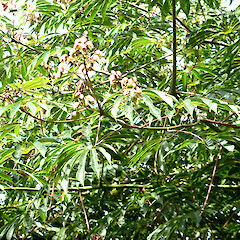Manihot grahamii
Common name
Hardy tapioca
Family
Euphorbiaceae
Flora category
Vascular – Exotic
Structural class
Trees & Shrubs - Dicotyledons
Conservation status
Not applicable
Brief description
Open-branched shrub or small tree; palmate leaves with 7-11 segments
Flower colours
Green
Life cycle
First seedlings collected in NZ in March 2018, near Whanganui
Year naturalised
2018
Origin
Brazil, Argentina
Tolerances
https://garden.org/plants/view/163715/Hardy-Tapioca-Manihot-grahamii/
Leaves and roots reportedly poisonous




